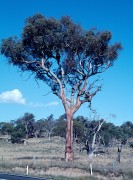 Loading... Please wait...
Loading... Please wait...
Our Products
Join our newsletter
Eucalyptus Rubida
Price:
SOLD OUT
Common Name:
CANDLEBARK GUM
PLEASE NOTE: Orders are by full tray only. Each tray contains 40 plants. When ordering, please choose how many trays you would like.
WHAT IT LOOKS LIKE:
- Tall tree with straight, largely bark-free trunk, 20-30m high.
- Timber tough, moderately hard and strong. Not durable.
- Flowering white from December to April.
- White trunk, interesting juvenile foliage and pink bark streaks in late summer are features.
- Leaves produce yellow dye with mordant alum.
WHERE IT GROWS & WHY:
-
Widespread, in most catchments and districts on the drier hills and slopes.Grassy woodlands on various soils. Commonly moderately fertile soils.Compact loams, below 800m elevation.Tolerates frost, winter waterlogging and drought.Widespread in the higher rainfall areas generally east of the Hume Highway.
- Moderately fertile, well-drained loams with clay subsoil, in foothills and tablelands. Also mountain slopes and upper river valleys.
- Well-drained soil. Resists cold, frost, wind and moderate drought.
MANAGEMENT/SIGNIFICANCE:
- Foliage has distinctive aroma.
- Useful medium to high level cover in windbreaks.
- Useful as fuel, although burns quickly.
- Excellent habitat. Hollows important nest sites for many native birds and mammals. Rosellas eat capsules and seeds. Koalas occasionally eat foliage. Flowers and nectar are a food source for various native birds, insects and mammals.
- Attractive for larger gardens and parks.
SIMILAR SPECIES:
- Distinguish from Eucalyptus Viminalis - Manna Gum - mainly by juvenile foliage.
Image Source: Fagg, M. via Australian National Botanic Gardens (ANBG)
- Home
- Eucalyptus Trees
- Eucalyptus Rubida
